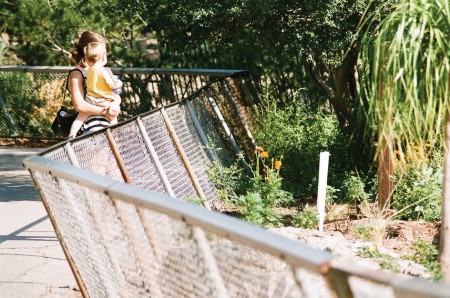Two giant Aldabra tortoises with wide dark eyes are on the move around their scrubby domain. The front one stops. Not willing to participate in gridlock, not wishing to change lanes, the rear tortoise climbs over the front one, like a Fiat driving over a stopped Fiat. The one underneath objects wrathfully and shakes the surmounter off. Another giant tortoise hauls himself over on thick pigeon-toed legs and the three of them face each other like the complacent lobes of a shamrock. A fourth tortoise in the shed has lost all his go.
Two female giraffes arrived in Tulsa ahead of the heat wave, one from Missouri and one from Kansas. For now, a fence separates them from the male giraffe, but the fence is low enough so they can “interact with his head.” They sniff his head, nuzzle his head, take cues from his head: at first the two of them were startled by all the roaring (the Tulsa Zoo is next to the airport), but then they looked at Samburu’s head, which was cool as a cucumber. He was born here in 1992, and knows that jet planes are as natural as wagons full of grape-eating children and the intermittent ditty of the carousel. A tall platform is being constructed where the carrot-bearing public will be able to climb up and “interact with the giraffes’ heads.” It must be a thankless job to be the body of a zoo giraffe, always transporting the far more popular head around. But recently Lexi and Pili were let into the main yard, to join Samburu in the circulating shadow of his canvas umbrella, a three-giraffe sundial.
It is so hot the leaves flash like mirrors. The cicadas get riled up and cottonwood fluffs around. Two little gray Sicilian donkeys marked like hot-cross buns are in a stupor. A spindly little girl in the Frogger Jumping Harness dangles in the air like a pixie, too light to actually touch down on the green bouncy mattress. Gravity can be a good friend, but I have noticed that he plays favorites. Three chunky zebras are safely grazing; the cheetah lives behind an unleapable fence. Oklahoma looks like Botswana, especially the clouds and the zebras, but you can tell you’re in Oklahoma because the cheetah is visible.
In the Children’s Zoo, a red wattle hog mixes himself some mud with his snout—start with some dirt, add some sump water, a little more dirt, mix mix mix—and plunks himself down in the oozy sludge, his big notched ears flapping forward over his eyes. His explanatory plaque says that red wattle hog numbers dwindled when people found fattier hogs for making soap. It also says that red wattle hogs have some wild relatives in Texas—the Texas relatives must have quit the soap-making business to pursue mud-making full-time. In the Contact Yard, I try to make contact with an extra wide goat, stroking her rusty-wire hair. She does not appear to notice. One little crackpot goat is running around butting other goats in the rear, and they definitely notice. Here is someone who knows how to make contact that sinks in.
A grizzly bear has her nose pressed against the window, watching the children watching her. Apparently she was found at the same dumpster or campground three times, and the rule is three strikes and you’re out, and they know who you are because they tattoo your lips. Grizzly bears have such a powerful sense of smell that even if tranquilized, crated, trucked 300 miles away, lectured to stay put and eat the local ladybugs and huckleberries and wild potatoes, they still might show back up behind Buckshot Bessie’s Bar and Grill, ransacking that peerless dumpster, that consummate dumpster, that dumpster surpassing all dumpsters. The polar bear died so the Tulsa Zoo had room for a recidivist.
The Embassy of Dead Branches
A Scottish Highland cow with shaggy red bangs and tufty eyelashes is breathing so heavily that her long curved horns rock back and forth. The word animal comes from the Latin word for “having breath.” Every time I walk by the alligator snapping turtle’s aquarium he is slanted up his slope of rocks. I don’t understand why he’s always in the same position until I see him stretch his head up to the surface to breathe. His stony-plated armor looks fortified for fending off Gog and Magog, but here, submerged in his tank in Tulsa, all he needs to fend off is a small fish friend and death, so he positions himself for convenient access to air.
Close to a mini-bayou graced with two alligators and a cabana, there is a triptych of small embassies: swamp, bog, marsh. The barking tree frogs representing marsh are stuck to the wall. The tiny bog ambassador is lying exposed in a dish of mud; the description of bog turtles says “they are very secretive.” She is not alone among secrets, having been transferred from a ferny bog into the public eye. Appearing for swamp is a spotted turtle that could fit in the palm of my hand, swimming hard into the window, making the water churn around his fake mangrove roots. As I walk back and forth he follows me, climbs onto his minute bank, falls pinwheeling into the water, paddles back to the glass, cranes his neck towards me. If he were an ambassador from outer space instead of just a swamp, I guess we’d all be amazed; or if he were a manmade turtle programmed to mechanically paddle after a person. I wish I were Ariadne, I wish I had a ball of thread.
In the back of a heptagonal snow-and-sky diorama, furnished with dead-leafy branches, a snowy owl sits swiveling his head to the left, around to the right, around to the left. Two different people who pass by inform their companions that owls can turn their heads all the way around but they wonder why he doesn’t do it. A hefty girl pounds on the glass and shouts, “That is a sexy owl!” Two teenagers in cut-offs conduct an antiphonal conversation involving someone else on the other end of a cell phone: “Have you been in the truck?” “I’ve never been in the truck.” “He says he’s never been in the truck.” A caravansary of preschoolers is ushered through. At first, they are excited that the owl has his very own bath, but then the excitement turns Aristotelian as they debate whether it’s a bath or a shower in a relaxing dual shower head. Pre-school does not mean pre-intellectual. The sign says “the snowy owl’s range includes the entire Arctic Circle.”
A few pre-intellectuals are strollered past the dwarf antelope huddling in the shadow of her twelve-foot wooden fence; they seem to be the only people not asking “What’s that?” “What the fuck?” “What the hell is that?”—the only ones whose interest in the animal is not deflected by the answer “a dik-dik.” One little boy waves at the antelope silently; two dark-haired babies in yellow dresses stare, open- mouthed; a small girl in gold-heart sunglasses cries out “Goodbye” as she is wheeled away. This all helps me understand why only two-year- olds are allowed to go on a Camel Tour:
- Riders must be 2 years old and able to hold on securely
- No kicking, biting, spitting, or other offensive acts toward the camels
- The load limit will not exceed 300 pounds
Two camels lie under a tent, patiently wearing blue seats. Who is worthy to be carried by such faithful creatures, except nonviolent two-year-olds under 300 pounds? Babies should qualify too, because of the hallelujah quality of their minds, but they might fall off.
The Wisdom of Gunda
Outside the chimpanzee house there’s a red metal outline of a chimpanzee bolted to the concrete. It looks like a chimpanzee cookie-cutter; a woman has her daughter get inside it, to compare physiques: “Scooch forward, stick your butt out—” A chimpanzee has very long arms and very short legs, so to fit in the outline a person has to contort herself. But none of the actual chimpanzees I see would fit in the cookie-cutter either, not Bernsen, the little pirouetting one, or the huge one, Morris, who catches flying bananas and lemons with one hand.
Somehow I sense I am living in the age of anatomical expertise. Signs at the zoo say things like “Langurs have tails up to 43 inches long,” “A chimp’s muscle tissue is denser than ours,” and “Elephant tusks are incisor teeth.” At the Elephant Demonstration, visitors ask, “How many bones do they have?” “How many toes do they have?” “How many teeth do they have?” An elephant has four molars like a dead elephant, but a dead elephant can’t hold a candle to Gunda here, enjoying her broccoli and her hose bath, her particular freckles emerging from the mud.
The elephant keeper, the giant tortoise keeper, the grizzly bear keeper, the chimpanzee keeper and the sloth keeper all tell me how different their animals are from each other, in their fearlessness, pushiness, irascibility, taste for togetherness, mothering styles, interest in people or antipathy to them. Three Fiats with homogeneous bodies will yet behave in heterogeneous ways, one creeping hesitantly to the pharmacy, another zooming to a toga party, and one, having forgotten to fill up, slowing down and stopping. You might think a sloth would have little behavior to differentiate it from its fellows, but Ty for one likes to sleep in a bucket, and after months of sweet-potato blandishments, does not mind the keeper lifting his long, curved nails up out of his bucket into the air. The only animals interchangeable like dollars are the ones not indigenous to this planet—the GloFish®. So that you must purchase the fluorescent fish from a retailer, the manufacturer makes them sterile. Perhaps something in this process has bent them out of true: all of the GloFish® at the Tulsa Zoo have the same personality: deceased.
Once the elephant keeper worked at a zoo where they’d take the elephants for a walkabout in forests and meadows, and he said if you didn’t keep an eye on them, you’d lose track of them, their footfalls are so silent. It’s true—I watch the male elephant trudging around his dusty yard, twirling the end of his trunk, swinging his tail back and forth, fanning his triangular ears, but I cannot hear him, gravity’s darling, any more than I can hear the dark purple butterfly fluttering back and forth in front of me. One got all the mass, the other got all the autonomy, but they are equally inaccessible to the ear. There is more than one way to escape scrutiny.
As I am leaving the zoo I pass a sign that asks, “What animals do you want to attract?” I consider and decide that, of all the animals I have seen here, I would most like to attract the red wattle hog and the reticent goat and the lithe green lizard I saw resting his chin on a log, and I enter the Habitat Garden to learn how. However, I find the Habitat Garden to be strongly skewed toward the attracting of toads. “Overturn a clay pot in a damp area for toads.” “Large rocks and rock piles make good shady places for toads.” “Attract toads with a slow-dripping faucet.” Although I am glad to learn how to sweeten the life of a toad, I leave the zoo not knowing how to be someone the hog, the goat, the lizard, the dik-dik, the gibbon, or the saki monkey, or the snowy owl want to be close to. In the parking lot, two little birds who were sheltering from the sun under my car fly away.


